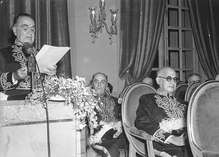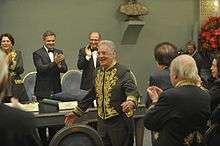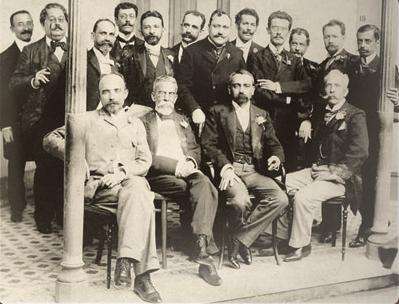Academia Brasileira de Letras
Coordinates: 22°54′39″S 43°10′23″W / 22.91083°S 43.17302°W
 | |
| Motto | Ad immortalitatem (To immortality) |
|---|---|
| Formation | 20 July 1897 |
| Headquarters | Rio de Janeiro, Brazil |
Membership | 40 members |
Official language | Portuguese |
President | Geraldo Holanda Cavalcanti |
| Website |
www |
Academia Brasileira de Letras (ABL) (Portuguese pronunciation: [akadeˈmiɐ bɾaziˈlejɾɐ dʒi ˈletɾɐs] (![]()
The Brazilian Academy of Letters is, according to its statutes, charged with the care of the "national language" of Brazil (the Portuguese language) and with the promotion of Brazilian literary arts. The academy is considered the foremost institution devoted to the Portuguese language in Brazil. Although it is not a state institution and no law grants to it oversight over the language, by its prestige and technical qualification it is the paramount authority on Brazilian Portuguese. The academy's main publication in this field is the Orthographic Vocabulary of the Portuguese Language (Vocabulário Ortográfico da Língua Portuguesa) of which there were five editions. The Vocabulary is prepared by the academy's Commission on Lexicology and Lexicography. If a word is not included in the Vocabulary, it is considered not to exist as a correct word in Brazilian Portuguese.
The academy is composed to this day of 40 members, known as "immortals", chosen from among the citizens of Brazil, who have published recognized works or books of literary value. The position of "immortal" is awarded for the recipient's lifetime. New members are admitted by a vote of the academy members when one of the "chairs" become vacant. The chairs are numbered and each has a Patron: the Patrons are 40 great Brazilian writers that were already dead when the academy was founded; the names of the Patrons were chosen by the Founders and they were honored post mortem by each being assigned patronage over a chair. Thus, each of the 40 chairs is associated with its current holder, with the predecessors of the current holder who occupied it before him, and, in particular, with the Founder who occupied it first, but also with the seat's Patron.
The academicians use formal gala gilded uniforms with a sword (the uniform is called "fardão") when participating in official meetings of the academy.
History
Foundation
The initiative was taken by Lúcio de Mendonça, concretized in preparatory meetings that began on 15 December 1896 under the presidency of Machado de Assis (elected by acclamation) in the writing of the Brazilian Journal. At these meetings, the statutes of the Brazilian Academy of Letters were approved on 28 January 1897, and its membership of forty founding members was approved. On 20 July of that year, the inaugural session was held at the Pedagogium's facility in the center of Rio de Janeiro.
Without having their own headquarters or financial resources, the meetings of the academy were held in the premises of the former National Gymnasium, in the Noble Hall of the Ministry of the Interior, in the hall of the Royal Portuguese Cabinet of Reading, especially for the solemn sessions. The joint sessions were held at the First Secretary's law office, Rodrigo Octávio, at Quitanda Street, 47.
From 1904, the academy obtained the left wing of the Brazilian Silogeo, a governmental building that housed other cultural institutions, where it remained until the conquest of its own headquarters.
Petit Trianon
In 1923, thanks to the initiative of its president at the time, Afrânio Peixoto and the French ambassador, Raymond Conty, the French government donated to the academy the building of the French Pavilion, built for the Independence of Brazil's Centenary International Exposition, a replica of the Petit Trianon of Versailles, erected by the architect Ange-Jacques Gabriel, between 1762 and 1768.
These facilities have been registered by the State Institute of Cultural Heritage (INEPAC), of the Municipal Secretary of Culture of Rio de Janeiro, since 9 November 1987. Its halls continue to the present day hosting regular meetings, solemn sessions commemorative meetings, the inauguration sessions of the new academics, as well as the traditional tea on Thursdays. They can be known by the public on guided tours or on cultural programs such as chamber music concerts, member book launches, conference cycles and plays.
On the first floor of the building, in the Hall, stands the decorated marble floor, a French crystal chandelier, a large white porcelain vase from Sèvres and four English bas-reliefs. Among other dependencies, the following stand out:
- the Noble Hall, where the solemn sessions take place;
- the French Hall, where the new member, traditionally, remains alone, in reflection;
- the Francisco Alves Room, where an oil painting on canvas by Rodolfo Amoedo is depicted, depicting a collective of nineteenth-century writers and intellectuals;
- the Hall of the Founders, decorated with period furniture and paintings by Candido Portinari;
- the Machado de Assis Room, decorated with the writer's desk, books and personal belongings, with emphasis on a portrait of him, by Henrique Bernardelli;
- the Hall of Romantic Poets has the bronze busts of Castro Alves, Fagundes Varela, Gonçalves Dias, Casimiro de Abreu and Álvares de Azevedo, by Rodolfo Bernardelli.
On the second floor there is the Tea Room, where the academics meet, on Thursdays, before the Plenary Session, the Sessions Room and the Library. The latter attends scholars and researchers, especially the collection of Manuel Bandeira.
Dictatorships

During periods like the Vargas' totalitarian dictatorship or the Brazilian military government, the academy's neutrality in choosing proper members dedicated to the literary profession was compromised when it elected politicians with few or no contributions to literature, such as ex-president and dictator Getúlio Vargas in 1943. The academy, which was a purely male affair until the groundbreaking election of novelist Rachel de Queiroz in 1977 for chair No. 5, now has four women members (10% of its total membership), one of which, Nélida Piñon, served as president in 1996–97.
Nowadays

The academy, thanks to revenues in excess of $4 million a year, is financially stable. It owns a skyscraper with 28 floors (Palácio Austregésilo de Athaide), in the center of Rio, which the academy rents for office space, generating 70% of its current revenue. The rest comes from rental of other buildings, which were legated by book editor Francisco Alves, in 1917, and from financial investments. This comfortable situation allows for paying a "jeton" to each academician. The ABL is located just by its side, in a neoclassical building, which is named "Petit Trianon". It was donated by the government of France in 1923 and is so named because it is a copy of the Petit Trianon palace in Versailles, near Paris, France.
It has recently inaugurated one of the largest public libraries in Rio, with 90,000 volumes and a multimedia center.
The academy annually awards several literary prizes: the Prêmio Machado de Assis (the most important literature prize in the country, awarded for lifework), and the ABL prizes for poetry, for fiction and drama, for essays, critic and history of the literature, and for children's literature. Sometimes, an extraordinary commemorative prize is also awarded, such as the José Lins do Rego prize, in 2001, and the Afonso Arinos prize, in 2005.
The academy also publishes a literary periodical, the Brazilian Review (Revista Brasileira), with quarterly editions.
Orthographic Vocabulary

The academy's main publication in this field is the Orthographic Vocabulary of the Portuguese Language (Vocabulário Ortográfico da Língua Portuguesa) of which there were five editions. The Vocabulary is prepared by the academy's Commission on Lexicology and Lexicography. If a word is not included in the Vocabulary, it is considered not to exist as a correct word in Brazilian Portuguese.
The Orthographic Vocabulary, however, is not a dictionary, as it contains words and their grammatical categories, but not the definition or meaning of the words listed. Thus, unlike the French Academy, the Royal Spanish Academy and other foreign institutions dedicated with the care of a national language, the Brazilian Academy of Letters, until recently, published no official dictionary. Although it still stopped short of publishing a full official dictionary, the academy issued its first dictionary in 2009, the School Dictionary of the Portuguese Language (Dicionário Escolar da Língua Portuguesa), with students as its target customers.
The academy does plan to publish a full and official Dictionary of the Brazilian Academy of Letters in the future. For the time being, however, other dictionaries such as the Aurélio and the Houaiss remain more prestigious than the School Dictionary, in spite of the fact that the latter is sometimes marketed by booksellers as the "ABL's Dictionary", due to its being authored by the academy. Both the Houaiss and the Aurélio Dictionaries, however, were first compiled by members of the academy (Antônio Houaiss and Aurélio Buarque de Holanda Ferreira, respectively) in their private capacities and as personal professional enterprises. The preparation of an official dictionary of the Portuguese language is a stated goal of the Brazilian Academy of Letters.[1]
Original patrons
- Adelino Fontoura
- Álvares de Azevedo
- Artur de Oliveira
- Basílio da Gama
- Bernardo Guimarães
- Casimiro de Abreu
- Castro Alves
- Cláudio Manuel da Costa
- Gonçalves de Magalhães
- Evaristo da Veiga
- Fagundes Varela
- França Júnior
- Francisco Otaviano
- Franklin Távora
- Gonçalves Dias
- Gregório de Matos
- Hipólito da Costa
- João Francisco Lisboa
- Joaquim Caetano da Silva
- Joaquim Manuel de Macedo
- Joaquim Serra
- José Bonifácio the Younger
- José de Alencar
- Júlio Ribeiro
- Junqueira Freire
- Laurindo Rabelo
- Antônio Peregrino Maciel Monteiro
- Manuel Antônio de Almeida
- Martins Pena
- Pardal Mallet
- Pedro Luís Pereira de Sousa
- Manuel de Araújo Porto-Alegre
- Raul Pompeia
- Sousa Caldas
- Tavares Bastos
- Teófilo Dias
- Tomás António Gonzaga
- Tobias Barreto
- Francisco Adolfo de Varnhagen
- José Maria da Silva Paranhos, Sr.
Correspondents
- Alexandre de Gusmão
- António José da Silva
- Manuel Botelho de Oliveira
- Eusébio de Matos
- Francisco de Sousa
- Matias Aires
- Nuno Marques Pereira
- Sebastião da Rocha Pita
- Santa Rita Durão
- Vicente do Salvador
- Alexandre Rodrigues Ferreira
- Antônio de Morais Silva
- Domingos Borges de Barros
- Francisco do Monte Alverne
- Joaquim Gonçalves Ledo
- José Bonifácio de Andrada e Silva
- Odorico Mendes
- Manuel Inácio da Silva Alvarenga
- Sotero dos Reis
- José da Silva Lisboa
Presidents
- Joaquim Maria Machado de Assis 1897–1908
- Ruy Barbosa 1908–1919
- Domício da Gama 1919
- Carlos de Laet 1919–1922
- Afrânio Peixoto 1922–1923
- Medeiros e Albuquerque 1923
- Afrânio Peixoto 1923–1924
- Afonso Celso 1925
- Coelho Neto 1926
- Rodrigo Otávio 1927
- Augusto de Lima 1928
- Fernando Magalhães 1929
- Aloisio de Castro 1930
- Fernando Magalhães 1931–1932
- Gustavo Barroso 1932–1933
- Ramiz Galvão 1933–1934
- Afonso Celso 1935
- Laudelino Freire 1936
- Ataulfo de Paiva 1937
- Cláudio de Souza 1938
- Antônio Austregésilo 1939
- Celso Vieira 1940
- Levi Carneiro 1941
- Macedo Sorares 1942–1943
- Múcio Leão 1944
- Pedro Calmon 1945
- Cláudio de Sousa 1946
- João Neves da Fontoura 1947
- Adelmar Tavares 1948
- Miguel Osório de Almeida 1949
- Gustavo Barroso 1950-1950
- Aloisio de Castro 1951
- Aníbal Freire da Fonseca 1952
- Barbosa Lima Sobrinho 1953–1954
- Rodrigo Otávio Filho 1955
- Peregrino Júnior 1956–1957
- Elmano Cardim 1958
- Austregésilo de Athayde 1959–1993
- Abgar Renault 1993
- Josué Montello 1993–1995
- Antônio Houaiss 1995–1996
- Nélida Piñon 1996–1997
- Arnaldo Niskier 1997–1999
- Tarcísio Padilha 2000–2002
- Alberto da Costa e Silva 2002–2004
- Ivan Junqueira 2004–2005
- Marcos Vinícios Rodrigues Vilaça 2006–2007
- Cícero Sandroni 2008
Current members
The members of the Brazilian Academy of Letters (October 2014):[2]
- Affonso Arinos de Mello Franco
- Alberto da Costa e Silva
- Alberto Venancio Filho
- Alfredo Bosi
- Ana Maria Machado
- Antonio Carlos Secchin
- Antônio Torres
- Arnaldo Niskier
- Candido Mendes de Almeida
- Carlos Heitor Cony
- Carlos Nejar
- Celso Lafer
- Cícero Sandroni
- Cleonice Berardinelli
- Domício Proença Filho
- Eduardo Portella
- Evaldo Cabral de Mello
- Evanildo Bechara
- Evaristo de Moraes Filho
- Fernando Henrique Cardoso
- Ferreira Gullar
- Geraldo Holanda Cavalcanti
- Helio Jaguaribe
- Ivo Pitanguy
- José Murilo de Carvalho
- José Sarney
- Luiz Paulo Horta
- Lygia Fagundes Telles
- Marco Lucchesi
- Marco Maciel
- Marcos Vinicios Rodrigues Vilaça
- Merval Pereira
- Murilo Melo Filho
- Nélida Piñon
- Nelson Pereira dos Santos
- Paulo Coelho
- Rosiska Darcy de Oliveira
- Sábato Magaldi
- Sergio Paulo Rouanet
- Tarcísio Padilha
- Edmar Bacha (joined in 2017)[3]
Gallery of the Immortals
See also
References
- ↑ "Língua portuguesa | Academia Brasileira de Letras" (in Portuguese). Academia.org.br. Retrieved 2015-08-01.
- ↑ "Membros | Academia Brasileira de Letras" (in Portuguese). Academia.org.br. Retrieved 2015-08-01.
- ↑ "A Brazilian inflation fighter becomes immortal". The Economist. 12 April 2017. Retrieved 14 April 2017.
External links
- Academia Brasileira de Letras (in Portuguese)